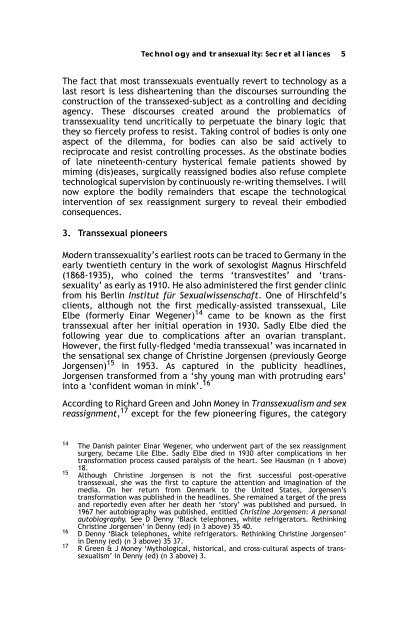Sex, Gender, Becoming - PULP
Sex, Gender, Becoming - PULP
Sex, Gender, Becoming - PULP
Create successful ePaper yourself
Turn your PDF publications into a flip-book with our unique Google optimized e-Paper software.
Technology and transexuality: Secret alliances 5<br />
The fact that most transsexuals eventually revert to technology as a<br />
last resort is less disheartening than the discourses surrounding the<br />
construction of the transsexed-subject as a controlling and deciding<br />
agency. These discourses created around the problematics of<br />
transsexuality tend uncritically to perpetuate the binary logic that<br />
they so fiercely profess to resist. Taking control of bodies is only one<br />
aspect of the dilemma, for bodies can also be said actively to<br />
reciprocate and resist controlling processes. As the obstinate bodies<br />
of late nineteenth-century hysterical female patients showed by<br />
miming (dis)eases, surgically reassigned bodies also refuse complete<br />
technological supervision by continuously re-writing themselves. I will<br />
now explore the bodily remainders that escape the technological<br />
intervention of sex reassignment surgery to reveal their embodied<br />
consequences.<br />
3. Transsexual pioneers<br />
Modern transsexuality’s earliest roots can be traced to Germany in the<br />
early twentieth century in the work of sexologist Magnus Hirschfeld<br />
(1868-1935), who coined the terms ‘transvestites’ and ‘transsexuality’<br />
as early as 1910. He also administered the first gender clinic<br />
from his Berlin Institut für <strong>Sex</strong>ualwissenschaft. One of Hirschfeld’s<br />
clients, although not the first medically-assisted transsexual, Lile<br />
Elbe (formerly Einar Wegener) 14 came to be known as the first<br />
transsexual after her initial operation in 1930. Sadly Elbe died the<br />
following year due to complications after an ovarian transplant.<br />
However, the first fully-fledged ‘media transsexual’ was incarnated in<br />
the sensational sex change of Christine Jorgensen (previously George<br />
Jorgensen) 15 in 1953. As captured in the publicity headlines,<br />
Jorgensen transformed from a ‘shy young man with protruding ears’<br />
into a ‘confident woman in mink’. 16<br />
According to Richard Green and John Money in Transsexualism and sex<br />
reassignment, 17 except for the few pioneering figures, the category<br />
14 The Danish painter Einar Wegener, who underwent part of the sex reassignment<br />
surgery, became Lile Elbe. Sadly Elbe died in 1930 after complications in her<br />
transformation process caused paralysis of the heart. See Hausman (n 1 above)<br />
18.<br />
15 Although Christine Jorgensen is not the first successful post-operative<br />
transsexual, she was the first to capture the attention and imagination of the<br />
media. On her return from Denmark to the United States, Jorgensen’s<br />
transformation was published in the headlines. She remained a target of the press<br />
and reportedly even after her death her ‘story’ was published and pursued. In<br />
1967 her autobiography was published, entitled Christine Jorgensen: A personal<br />
autobiography. See D Denny ‘Black telephones, white refrigerators. Rethinking<br />
Christine Jorgensen’ in Denny (ed) (n 3 above) 35 40.<br />
16 D Denny ‘Black telephones, white refrigerators. Rethinking Christine Jorgensen’<br />
in Denny (ed) (n 3 above) 35 37.<br />
17<br />
R Green & J Money ‘Mythological, historical, and cross-cultural aspects of transsexualism’<br />
in Denny (ed) (n 3 above) 3.
















